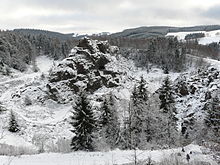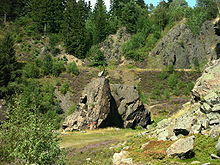Geyersche binge
The Geyersche binge is a by mining resulting Pinge in Geyer in the Saxon Erzgebirge . The two main fractures occurred in 1704 and 1803. The Binge has been a nature reserve since 1935 .
location and size
The Pinge is located on Geyersberg directly on the south-eastern edge of the city of Geyer on the outskirts of Siebenhöfen . Today it is 50 to 60 m deep and covers an area of around 200 m × 250 m.
history
Mining on the Geyersberg
On the Geyersberg in the southeast of Geyer, mining was first mentioned in a document in the years 1395 to 1400. Mainly tin was mined here, but also silver , copper and other ores. By merging seven mines, the first major mining company in the Ore Mountains was created in 1462, the privileged Thiermann-Stolln-Gesellschaft . In 1699 the transition to civil engineering began in the Hirtenstollen. Between 1739 and 1773, between four and ten tons of tin were produced annually. In 1767 and 1768, the “White Mine” mine produced a particularly large amount of 884 quintals of tin. In the years 1740 and 1741 there were 17 collieries, 25 stamp mills and washes and 4 tin works around Geyersberg. The mining was carried out to a depth of 106 m.
Origin of the binge
Due to the hard granite rock on the Geyersberg, the technique of setting fire was mainly used. About 10 cubic meters of rock had to be extracted to produce one hundredweight of tin. Thus, in a period of 400 years of mining activity, widenings of up to 40 meters in diameter and 35 meters in height were created. The many cavities and tunnels that were too close together, which were created by intensive overexploitation , ultimately became doomed for the mine under the Geyersberg.
A first major break underground led to the intensification of mining in 1704, as the broken masses were easier to extract. At that time, the twelve self-employed people and a 100-man workforce agreed on a joint drainage system. In 1773 the small businesses were taken over by the Saxon state . After the merger, the shares were reallocated.
In 1791 there was another underground breach and in 1795 the first pinge breach occurred , flooding the deeper mines . As a result, several companies had to close. The last and most fateful break occurred on May 11, 1803, when the entire mountain collapsed and the rock did not come to rest until November of that year. It led to the cessation of civil engineering . Since then, the "Knauers" rock massif has protruded from the crater-shaped depression. To this day, two buried miners rest under the rock masses. The former mine workings have a size of around 250,000 cubic meters. After mining was resumed to a small extent from 1809, it finally came to a standstill in 1851.
History of Geyer's Binge to the present day
From 1851 onwards, a quarry company gained the broken masses of the Binge. During this time the explosives chamber was built, the tunnel mouth hole of which was renovated in 2012 by the Bergbrüderschaft Geyer eV. The Binge was used particularly intensively as a quarry between 1895 and 1914 and 1919 and 1929. Thus, the current volume of the pinge was created not only through the collapse of the underground cavities, but also through its use as a quarry, which annually processed around 12,000 cubic meters of broken mass. Since tin stone, arsenic gravel and bismuth were repeatedly found in the quarry, mining was resumed in 1907 and the Franz shaft was sunk. As early as 1913, after six years of mining, the company went bankrupt. In 1935 the binge was placed under nature protection.
The last mining era began in the 1950s. In 1957, newer technology was used to attempt to open up and deepen the Franz shaft, which in 1958 enabled some residual deposits to be tapped. About 200,000 cubic meters of open cavities were discovered that had withstood the great Bingenbruch. Until 1960 exploration work was carried out with a negative outcome. In 1969, there were renewed break-ins in parts of the binge. In 2011 and 2012 the new shepherd's tunnel was renovated to ensure the controlled drainage of water from the binge. The Huthaus an der Binge was built in 1994 by the city of Geyer. It serves as a domicile for the Erzgebirgszweigverein Geyer.
tourism
The approx. 60 meter deep collapse basin can be viewed on paved paths. Furthermore, the upper edge of the binge can be walked around. Boards outside and inside the binge give information about their history. A nature trail leads around the crater of the Binge, providing information about geological conditions and rare plants and animals. In the summer months, from May to October, themed tours on mining history, the history of the binge and the collapse crater, fire-setting and old mining technologies and special tours for children are offered.
Web links
- Virtual guidance
- The Geyersche Binge on the website of the city of Geyer
- The Geyersche Binge (on mineralienatlas.de) , accessed on April 29, 2018
Individual evidence
Coordinates: 50 ° 37 '16 " N , 12 ° 55' 41.8" E





